Lizardfolk are one of the more bestial races available to players in 5e. They are nearly exclusively motivated by hunger and the desire for food.
They don’t value riches or information that isn’t immediately useful to them.
As a player, this can be a lot of fun to roleplay, and their racial features provide some interesting possibilities to include into various builds.
If you wish to play a Lizardfolk adventurer, here is a Lizardfolk 5e Guide that will teach you everything you need to know.
What are Lizardfolk in 5e?
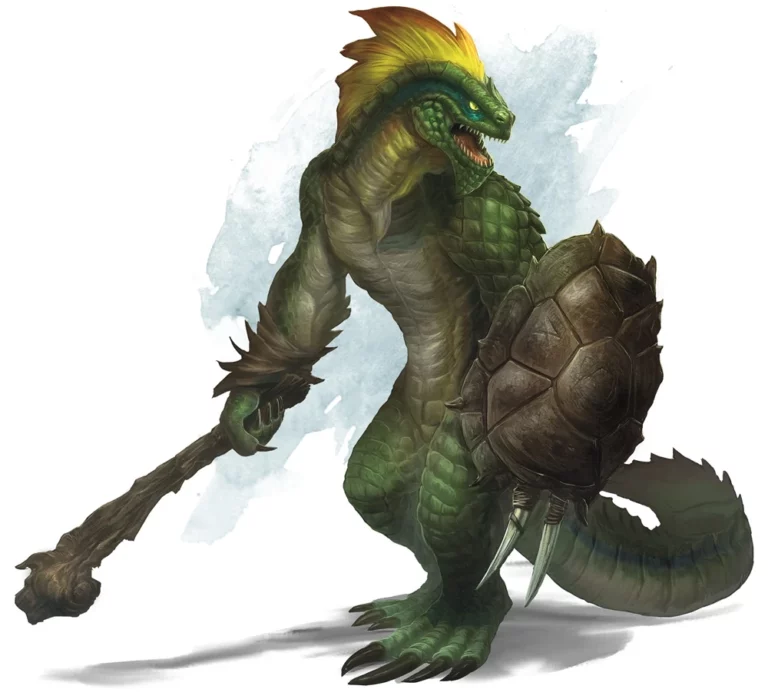
Books include Volo’s Guide to Monsters and Mordenkainen
Presents: Monsters of the Multiverse.
Editions include 1e, 2e, 3e, 4e, and 5e.
Appearance: Humanoid lizard-people with long tails and talons on their hands and feet, as well as fins running down their heads and necks.
Lizardfolk are not your ordinary swamp dwellers. Unlike races like the dragonborn, the minds of lizardfolk are fundamentally different from the minds of most sentient beings in the universe of D&D.
Lizardfolk perceive the world in a much more fundamental sense, perceiving emotions in a simpler way and classifying people they encounter as either predator or prey.
Their emotions are essentially rooted on fear, aggression, and pleasure, with survival and practical value taking precedence over anything else.
A lizardfolk will keep you around and even protect you if you are helpful to them. If you die in their presence, at the very least you’ll make a nice lunch.
Lizardfolk Lore
The Lizardfolk’s past can be difficult to trace because they don’t preserve any records of their own. Instead, people recall important aspects of their history through handing down stories from generation to generation.
At the same time, references to the Lizardfolk from many cultures might be used to piece together other aspects of their history. Combining these two, however, only provides a partial view.
The Lizardfolk believe they were the first humanoid species on the Forgotten Realms continent of Toril. They believe that they were born in the land’s wetlands and that other species and other civilizations are derived from the Lizardfolk.
They believe that those other species developed from the weakest Lizardfolk who couldn’t tolerate life in the marshes and set out to make life simpler for themselves by forming civilizations.
Other races believe that Lizardfolk are descended from the Sarrukh, an ancient race. Whichever explanation is right, it appears that the Lizardfolk culture was among the first in the Forgotten Realms, and it has remained largely intact.
Smaller enclaves of Lizardfolk were later dispersed around the lands after being enslaved by more advanced races.
They almost always managed to escape their captors and go into the nearby marsh to start their lives over. Once they were securely back in the swamps, they proved too difficult to capture due to the difficult-to-penetrate terrain, allowing them to live in relative peace once free.
Lizardfolk Society
While Lizardfolk are opposed to more evolved contemporary cultures, they nonetheless prefer to band together to increase their chances of survival. Lizardfolk prefer to live in small tribal villages in the swamp.
These tribes can include up to 150 members and a variety of adult-to-hatchling ratios. These tribes are usually governed by men, but any tribe member might challenge the chief to a fight for the right to rule. tribe members’ responsibilities are decided by their gender, with males serving as warriors and lieutenants and females raising children and maintaining the tribe camp.
Their young are born in clutches of eggs that must be kept warm and safe from predators. Lizardfolk prefer to employ the most rudimentary weapons imaginable, which can be fashioned at any time from their surroundings.
As a result, their nests are frequently nothing more than clumps of grass or other plants. Their primitive lifestyle also prevents them from developing food supplies through farming or animal husbandry, leaving them to rely solely on hunting, fishing, or stealing from others.
It’s no surprise that Lizardfolk rarely wander outside of their own tribe, given how often they look down on other races from outside their swamp. If they do, it is usually to acquire information for the chief of their tribe or to hunt large game that can be brought back to feed their family.
Any Lizardfolk who finally leave their tribe tend to stay in groupings with other Lizardfolk out of fear of being corrupted by society and losing sight of who they once were.
Lizardfolk worship Semuanya, a lesser deity who was previously greatly concerned with the survival of the species. Tribal clerics lead their worship of Semuanya and connect with their deity through ceremonies.
However, Semuanya finally abandoned the Lizardfolk in favor of allowing them to live on their own merits and strength. This caused many Lizardfolk to worship nature itself instead, and it also inspired burial ceremonies in which they ate their dead to help the tribe thrive.
Lizardfolk Traits
The Lizardfolk have been officially released in two versions: Volo’s Guide to Monsters and Mordenkainen Presents Monsters of the Multiverse.
So, if you want to play a Lizardfolk, you must first determine which one you want to play based on its mechanics or the book you have accessible.
If you’re unsure, I recommend consulting your Dungeon Master before creating your character.
There are, nevertheless, some parallels between the two. Lizardfolk are supposed to achieve maturity around the age of 14, and they rarely live to be 60.
They do, however, grow slightly larger than ordinary humans, giving them a medium size, a medium walk, and a swimming speed of 30 feet. They are also fluent in both the Common and Draconic languages.
Volo’s Guide to Monsters
Lizardfolk characters begin with a Consitution boost of two and a Wisdom increase of one in Volo’s Guide to Monsters.
This displays their fortitude as well as their ability to observe and learn from their harsh circumstances. Their primary racial characteristic is their Bite attack, which can be employed instead of unarmed blows.
These attacks deliver piercing damage of 1d6 + your Strength modifier, which is an improvement above unarmed strike damage.
They also include the Cunning Artisan feature, which allows you to cart a shield, club, javelin, or darts out of the corpses of foes while resting.
However, you can only use this ability if your character possesses a blade or a set of tools capable of doing so.
Lizardfolk can also use their Hold Breath feature to hold their breath for up to 15 minutes.
Their Hunter’s Lore ability also grants them proficiency in two of the following skills: Animal Handling, Nature, Perception, Stealth, and Survival, which is useful for rounding out your character’s talents outside of combat.
Lizardfolk also have Natural Armor, which grants them a natural armor class of 13 + your Dexterity modifier. Even if your character is wearing armor, you have the option of using their Natural Armor rating instead.
Lizardfolk have Hungry Jaws as their final racial trait. This permits you to use your extra action to make a Bite attack once every short or long rest.
If the attack is successful, you gain temporary hit points equal to your Constitution modifier from the target’s bite of flesh.
Mordenkainen Presents: Monsters of the Multivers
The Lizardfolk have been reworked for players who want to play them in Mordenkainen Presents: Monsters of the Multiverse. The first alteration is that their Cunning Artisan function has been removed.
Their Bite attack was also altered to provide cutting damage rather than piercing damage, as well as being classified a standard unarmed attack rather than a natural weapon.
The Hunter’s Lore feature has also been altered to Nature’s Intuition, which allows Lizardfolk to select two of the following skill proficiencies: Animal Handling, Nature, Medicine, Perception, Stealth, and Survival.
Finally, their Hungry Jaws trait has been updated so that it can be used numerous times every long rest according to your character’s proficiency bonus, and the temporary hit points gained are similar to your proficiency bonus rather than your Constitution modifier.
Roleplaying a Lizardfolk
To me, the most fascinating component of playing a Lizardfolk in 5e is not the mechanical characteristics of the race, but rather the unique roleplaying implications of the race.
Because of how secluded Lizardfolk grow up in their swamps, your character will be amazed by the majority of what they come across during their adventures.
How they react to these discoveries will depend on how you want to play them, as they can find them foolish and weak, or they can be amazed at what their tribe is missing.
Of course, you’ll have to figure out what led your Lizardfolk to abandon their tribe, which is extremely unusual.
There are several methods to accomplish this, whether it be a huge tragedy that drives them away from their tribe, seeking to discover something in the larger world that they require, such as a cure for a disease, or simply a youthful wanderlust that causes them to reject their racial culture.
You should consider what motivates your Lizardfolk’s activities while you roleplay them. Because Lizardfolk are often driven by little more than hunger and their immediate needs, playing a character that doesn’t care about money or other incentives can be a lot of fun.
However, you must be careful not to let this directly collide with the interests of your party, as this will make your character less enjoyable for everyone else to play with.
To that end, I urge that your Lizardfolk not be seduced by money or knowledge that they would find useless, but rather that they not be driven to go against the group or not play well with their party members.
Which 5e Classes Work With Lizardfolk?
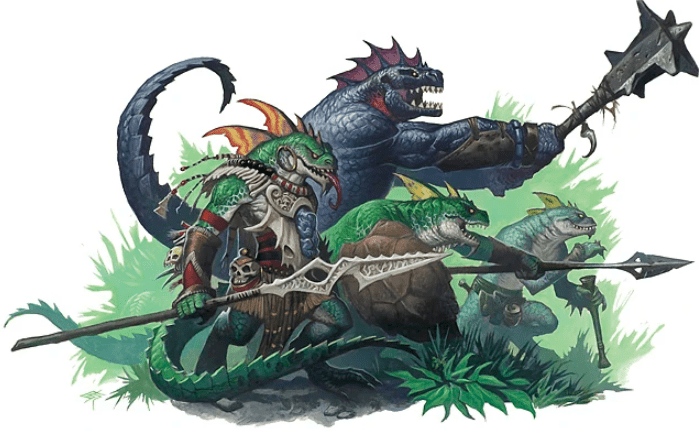
Lizardfolk can easily make the squishier classes more robust thanks to the massive boost to CON and Natural Armor, but they will be short in their major stat if they don’t employ WIS for spellcasting.
You should put some points into DEX to get the most out of Natural Armor. The rest of the lizardfolk’s racial characteristics are useful to any build.
Artificer: To be effective, artificers require INT.
Barbarian: To be effective, barbarians require STR, and Natural Armor does not stack with Unarmored Defense.
None of the lizardfolk’s ability scores pique the curiosity of bards.
Cleric: CON and WIS are excellent starting points for a cleric. A DEX-based cleric might go well with Natural Armor.
Druid: Druids are extremely squishy, often battling with a limited hit point pool and poor AC. Lizardfolk provide druids with an excellent way to increase their AC, hit points, and even WIS for spellcasting.
Fighter: Although the WIS ASI isn’t really useful, the array can still be used by a DEX-based fighter. As a DEX-based fighter, your CON and Natural Armor will get you far, but a breastplate will improve your AC.
Fighters get a lot of ability score increases, so they should have no trouble getting their stats up to where they need to be, but you should usually use these ASIs to pick up feats.
Monks benefit from CON and WIS. This class already has Unarmored Defense, which has a lower base AC but uses both your DEX and WIS modifiers. This means that Natural Armor will be superior until your DEX and WIS are both sufficiently high.
Paladin: WIS is mostly useless for paladins because they rely on multiple other ability scores. Hungry Jaws also doesn’t appear to be all that intriguing, given paladins are already excellent at healing and self-preservation. A DEX-based paladin will suffice because they will not rely on STR and heavy armor for AC.
Ranger: A lizardfolk ranger will have a rough start without DEX, but the extra survivability should serve you well until you gain some ability score boosts. WIS is useful for spellcasting.
Rogue: Rogues are thirsty for DEX, which is severely lacking in this instance. Rogues, on the other hand, are always eager to have more skill proficiency to play with, and Natural Armor will eventually offer you a massive AC when DEX is maxed out.
Sorcerer: In order to be effective, sorcerers require CHA.
Warlocks require CHA to be effective.
Wizards require INT to be effective.
FAQs
How Old Do Lizardfolk Get?
On average, lizardfolk have a significantly shorter life span than humans. Lizardfolk achieve adulthood around the age of 14, and most do not live past the age of 60. There are exceptions to these norms, as with any species.
Who is the Lizardfolk God?
While the answer varies according on the setting, most Lizardfolk in Forgotten Realms revere Semuanya. Tribal shamans pray to Semuanya for protection in combat or on the hunt. Semuanya is the patron goddess of the Lizardolk, as well as the god of survival and reproduction.
How Tall Are Lizardfolk?
Lizardfolk are very tall for humanoids. Lizardfolk stand between 6 and 7 feet tall on average. Their slim size might hide their height, especially if they adopt a stooped stance.
WHy Do Lizardfolk Speak Draconic?
Despite their lack of draconic ancestors, Lizardfolk commonly speak draconic in the Forgotten Realms. Many lizardfolk tribes love dragons, and it is thought that lizardfolk learned draconic aeons ago while serving the dragons they adored.
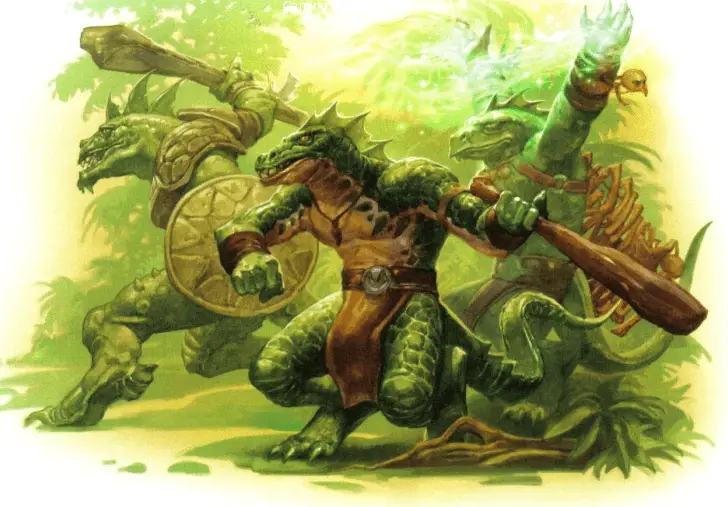
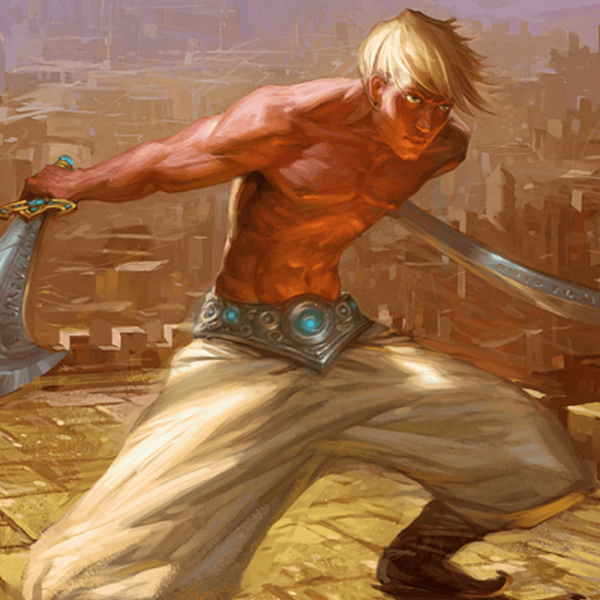
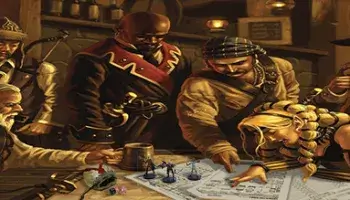
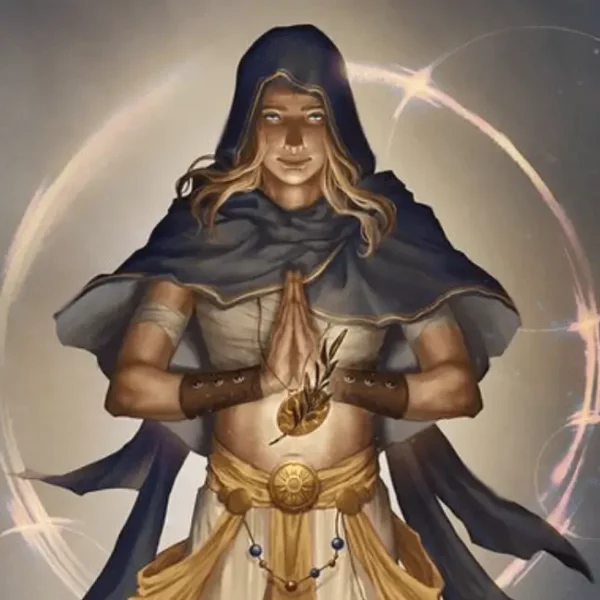


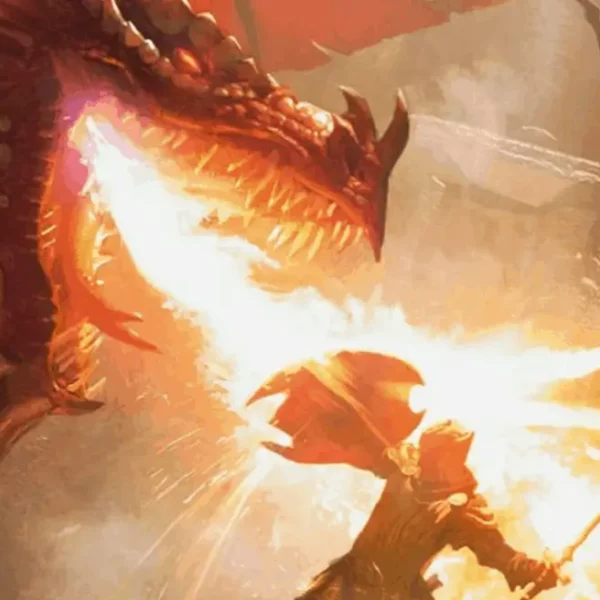
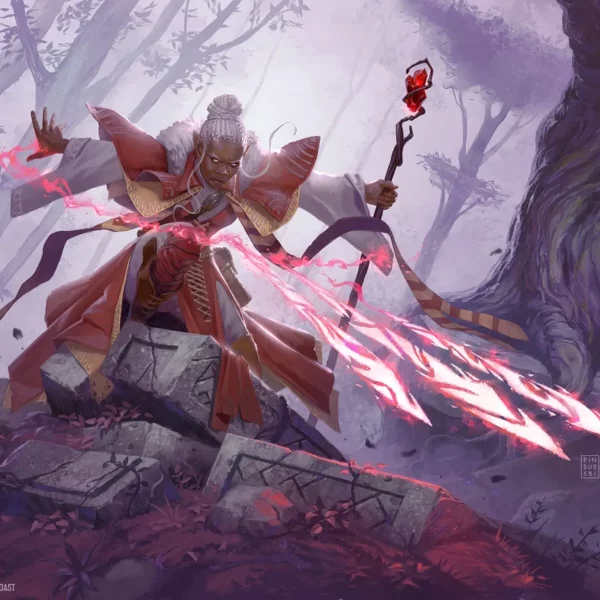


Leave a Comment